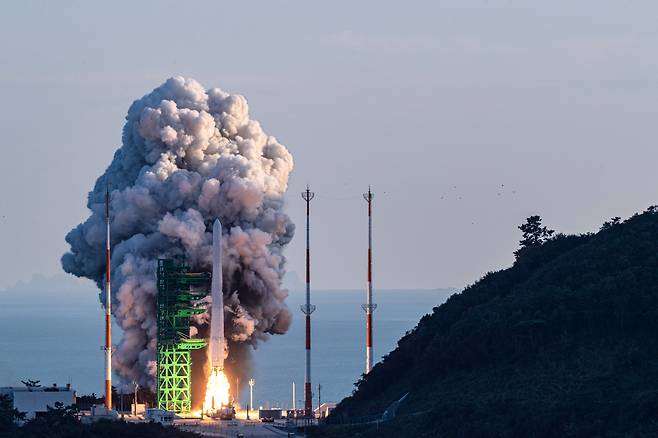Korea sees silver lining in Nuri launch
이 글자크기로 변경됩니다.
(예시) 가장 빠른 뉴스가 있고 다양한 정보, 쌍방향 소통이 숨쉬는 다음뉴스를 만나보세요. 다음뉴스는 국내외 주요이슈와 실시간 속보, 문화생활 및 다양한 분야의 뉴스를 입체적으로 전달하고 있습니다.

South Korea’s first homegrown satellite launch vehicle has failed to put its payload into the targeted orbit after what appeared to be a successful liftoff, the government said Thursday.
The satellite launcher, dubbed the Nuri, or Korean Space Launch Vehicle-II, lifted off from the Naro Space Center in Goheung, South Jeolla Province, Thursday at 5 p.m.
According to the Korea Aerospace Research Institute, it successfully traveled into a low orbit 700 kilometers above the Earth. The liquid-fuel rockets and the payload fairing were also separated from the 1.5-ton dummy at the appropriate time.
The dummy, however, failed to enter the targeted orbit, KARI concluded.
The chances of success were considered slim. KARI previously said that only about 30 percent of newly built spacecraft succeed on their first attempt.
“The Nuri has failed to complete its mission,” President Moon Jae-in said in a nationally televised address. “Putting a payload into a targeted orbit remains unsolved, but sending the rocket into a 700-kilometer orbit itself is a great achievement.”
A 1.95 trillion won ($1.66 billion) project lasting over a decade, the Nuri has carried, along with its mock payload, Korea’s ambition to reach space with its own technology.
The country had previously launched a space booster called the Naro in 2013 with the help of Russian engineers. The Nuri is designed and built entirely by Koreans.
Moon said the government will invest 687.4 billion won for additional launches, reiterating the country’s goal of sending a probe to the moon by 2030.
The Korea Aerospace Research Institute, which leads the country’s space program, including the Nuri project, already has plans for upgrades for future models of the Nuri.
The next test is scheduled for May 19, and the Nuri will also carry actual satellites weighing 200 tons.
With the next Nuri model, Korea aims to become the world’s seventh country with independent capabilities to launch a satellite weighing over 1 ton from its own soil.
While building new satellite launch vehicles, the government will share related technologies with private firms to help them build their own rockets by 2024.
President Moon added that the government plans to secure technologies and build a moon rocket by 2030.
The Nuri is a result of the country’s investment over the last 11 years and seven months.
In 2009, Korea tried its luck at launching the country’s first orbital rocket, Naro, also known as KSLV-I. In 2013, after two failed launches, the country succeeded, making it the world’s 11th country to reach orbit.
Korea has invested some 2 trillion won to build a satellite launch vehicle on its own.
For the Nuri project, the country has made some 370,000 parts and completed 184 engine tests, with support from 300 local companies.
By Shim Woo-hyun(ws@heraldcorp.com)
Copyright © 코리아헤럴드. 무단전재 및 재배포 금지.